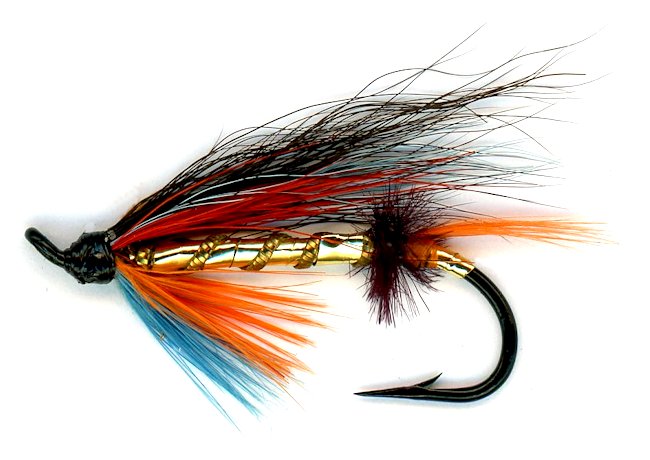The Dunkeld Salmon Single Hook Fly
The Dunkeld is one of the very old early 19th century salmon patterns that has undergone considerable change and development over the years.

SALMON AND STEELHEAD SINGLE HOOK FLY PATTERNS. Hook size 6 8 - $US each
The Dunkeld fishing fly should be fished during early summer mornings and late autumn/fall evenings when it has produced some great results. Sea trout fly fishermen always say never use a Dunkeld in late summer as it will always catch a salmon and not a sea-trout. This is good news if you are hunting salmon. The fly was named after a small Scottish town in Strathtay. It is 15 miles north of Perth. What is important about this town is its situation. It is on the north bank of the River Tay. There is accommodation, such as the Atholl Arms Hotel or Dunkeld House, near to the river which is ideal for visiting fly fishermen.
There are a number of lochs near by that offer trout fishing. The Dunkeld fly catches brown and rainbow trout. It is a great all round attractor fly. I believe the trout take the fly mistaking it for a caddis. In the larger sizes the tinsel body makes it look like a young juvenile fish. I have used the Dunkled on the west coast of America to successfully catch Cutthroat Salmon near the river mouth by the Pacific Ocean where the salt water mixes with the fresh water coming down from the mountains. When used in a team of flies I have found the best position is as a middle dropper.
The term "wet fly" could be given to any fishing fly fished sub-surface. Most fishermen recognise the wet fly to be the style of dressing and patterns developed by the early Scottish and Irish loch fly fishing Gillies for their own and client’s use over the past 300 years.
The best designs that consistently produced fish, gained popularity and eventually spread around the world. Flyfishing officers of the Royal Navy, British Army and high ranking civil servants in the British Empire on overseas postings were some of the first to try these flies in foreign waters and spread the word.
There are hundreds of different patterns, using all kinds of furs, feather, fibres, wool and hackles. Some original dressings were a mixture of relatively simple plain colours, while others were very bright combinations using generous amounts of gold and silver tinsel.
This latter wet-fly type was very pleasing to many anglers sense of colour co-ordination, never mind what the trout thought about the fly. This is why such flies are classed as attractor patterns as they did not try to imitate any particular insect or small fish.
An example of this is the very popular and successful Peter Ross wet fly pattern that uses red, silver, black and white. The Silver March Brown is different. It has a silver body and dark wing. It imitates a small fish. The Mallard and Claret wet fly is an imitation of a drowned caddis. The Invicta wet fly is an imitation of a hatching caddis. The Greenwell’s Glory is supposed to imitate an olive mayfly. Wet flies are looked upon as having either an imitative quality, however tenuous it may be, or are simply flashy and are classified as attractors.
The Dunkled wet fly that uses gold, orange and brown is also classified as an attractor but I think this is a wrong classification as many young trout have a pale yellow tummy and dark back when viewed in brown peat stained water. I believe the reason trout, grayling and salmon take this fly is because they see it as a juvenile bait fish swimming past their nose.
Wet fly wings have so often been regarded as superfluous by fly tiers. This thinking is understandable, since you rarely see winged flies moving underwater. However most wings are dressed very skim and can clearly be seen only from the side. Many of the wings are dark in colour and blend in with the background when submerged. So what purpose dose the wing on a wet fly pattern serve?
The wings’ shape, colour and flashiness may contribute yet another imitative characteristic. A number of nymph patterns have tinsel ribbed bodies which add a sense of translucence. A look that the natural mayfly or caddis pupa’s body acquires pending emergence into the adult dun’s body. It is caused by an increase in its internal body fluid which helps with the shedding of the nymphal case when the pupa reaches the surface.
In smaller sizes the wing of the Silver March Brown, when fished on a middle dropper, looks like the body of a rising pupa, The silver body represents the translucent section of the body that will crack open and the fine throat hackle the insects wiggling swimming legs. Hair wing or hackle wings can help with the illusion of a swimming pup fighting to get to the surface. This is helped if the still water fly fisherman casts his flies and lets them settle before retrieving them. A pause in the retrieve adds to the swimming movement of the wing and throat hackle.
It is all too easy to just pick out the pretty wet fly or the one that caught fish last time you were on the water. Stop and think about your choice. What are the weather and water conditions? Where do you suspect the fish are feeding and what are they feeding on? It pays to think about what you are trying to achieve and why.

